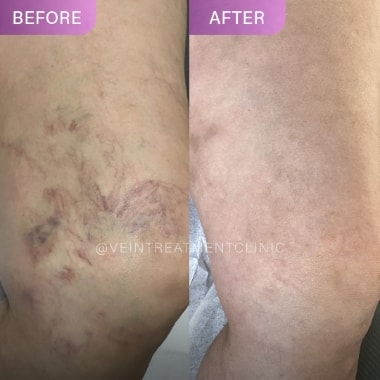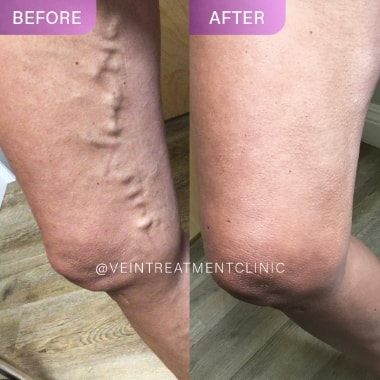Vein diseases
Signs and symptoms of vein disease are typically mild in the early stages. However, leg soreness tends to get worse with time and potentially more serious issues can arise.

Treated spider veins

Treated varicose veins
Venous Insufficiency
Males and women of any age can develop venous insufficiency, but women are more susceptible than males, and vein illness tends to grow more prevalent as people age.
Varicose Veins
Varicose vein disease is more likely to affect women than men for a variety of reasons, including familial history, obesity, advanced age, pregnancy, immobility, previous blood clot history, and gender.
Spider Veins
Spider veins are more common in people over the age of 50 than in younger people. Varicose veins and spider veins have a lot in common. Although varicose veins are larger on average than spider veins, they can occasionally be found simultaneously.
Spider veins can cause throbbing, swelling, and restless legs as well as be asymptomatic (painless).
There are many things that might cause spider veins. These risk elements consist of the following: older age, pregnancy, obesity, hormone therapy (HT), lengthy periods of standing or sitting, birth control, and family history
Leg Cramps
Leg cramps can be brought on by prolonged exertion or physically demanding activities, particularly in hot temperatures. Venous insufficiency is the most frequent cause of recurrent leg cramps, and treating leg cramps necessitates addressing the underlying vein disease.
Leg Swelling
Salt retention, pregnancy, congestive heart failure, cellulitis, venous insufficiency, and drug side effects are among the common reasons of leg edema.
The best strategy to treat leg swelling is to deal with the underlying problem. Leg swelling can be addressed with conservative techniques like wraps or compression stockings.
Leg Heaviness
Leg heaviness caused by venous disease usually gets worse after extended periods of sitting or standing. Symptoms typically get better with exercise, and get worse with heat.
Consider visiting a skilled vein doctor to be assessed for venous insufficiency if you have experienced leg heaviness at the end of the day, especially if you have visible spider and varicose veins on the surface of the skin.
Restless Leg Syndrome
Both men and women can get restless legs syndrome, but women are more likely to get it. At any age, it can begin. Adults in their middle or later years make up the majority of those who are severely impacted.
Your attitude, concentration, performance at work or school, and personal relationships may all be negatively impacted by restless legs syndrome, which can also lead to daytime sleepiness and weariness. Most RLS sufferers report having poor memory, finding it difficult to focus, or even struggling to complete chores.
Consider getting evaluated by a skilled and experienced vein doctor if you have symptoms of restless leg syndrome and visible veins because this condition may be caused by underlying venous insufficiency.

